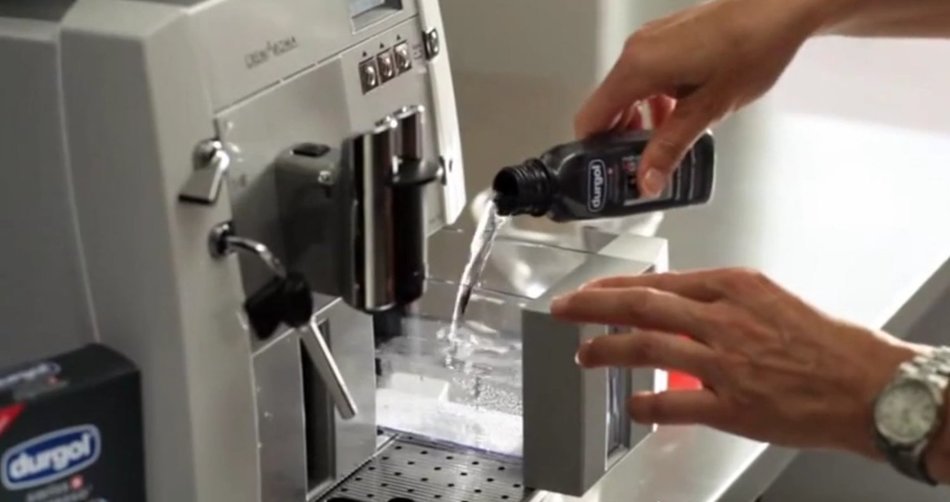When I first purchased my Breville Barista Express coffeemaker, I was thrilled. It made better than average coffee. In time, however, I knew I needed a great descaling of my machine. I put it off the deep cleaning because I thought it would be a difficult task. In my mind, all I could think of is that it would take a long time, so I ignored the question, “how to descale an espresso machine?”
Fast-forward, and I decided to do a little research on descaling a coffee machine. Descaling means to remove the limescale deposits on the parts where the water flows. Limescale is chalky, off white, and stone-like residue. This residue is left by hard water on the metallic parts of water-operated machinery.

Descaling An Espresso Machine (How To Do It)
When limescale builds up on your machine, it slows it down. Next thing you know, it now requires more energy to work, which makes your electricity bill higher. Besides, it can decrease the functionality of that budget espresso machine you worked so hard to get. You can have maintenance issues when the device isn’t appropriately descaled.
Below are methods of descaling single or automatic models. You can choose among:
- Citric acid
- White vinegar
- Commercial descaling solution
According to Sherry Harris, founder of Coffee Shop Lady, “Top brands like Jura, Gaggia, and Breville are expensive coffee makers. Therefore, those products come with a manual with descaling instructions by the manufacturers. So, by all means, please follow those instructions before jumping into the descaling process.”
Keep in mind descaling a super-automatic is quite different from descaling a single boiler. Other machines have different procedures.
Descaling Super-Automatic Espresso Machines
If your machine has an automatic descaling feature, you can just run the recommended descaling solution through the machine. If there isn’t an automatic feature, follow the instructions below.
- Dissolve the solution into the full reservoir in the machine’s boiler
- Pour one cup of water into the steam wand
- Close the steam knob
- Turn on the machine
- Let the solution sit for 20 minutes
- Turn the device on again
- Let it sit for another 20 minutes
- Flush the water in the steam wand
Finish the descaling process by running clean water into the reservoir through the machine to let the solution completely flush.
Descaling Single Boiler Espresso Machines
When you are descaling your single boiler machine, you must follow the directions. Most important is dissolving the descaling solution into the full reservoir and pulling it into the boiler.
Just like with descaling automatics, you turn on the machine and run one cup of water through the steam wand, then you close and secure the steam knob. Next up, please turn it off and let the solution sit for 20 minutes. Letting it sit will help to descale the machine thoroughly.
After the 20 minutes have passed, turn the boiler on again and let it run through the steam wand. Repeat the procedure and flush the reservoir solution and rinse it with clean water at least twice.
On average, most do this process every three months. However, if you are a heavy coffee drinker, you can descale your machine more often. For instance, 300 capsules can be the ideal number.
When Do I Need To Descale My Espresso Machine?
Whatever type of espresso machine you use to brew coffee at home, you can learn to descale quickly. If you want your espresso machine working at optimum levels, you will stick to cleaning it regularly and descaling quarterly.
Descaling your machine will prevent mineral buildup, keep you from getting sick from bacteria, yeast and mold, it will keep your coffee from tasting bad, and it will keep your machinery from clogging.
Also, regular use of hard water while brewing coffee in an espresso can build up a high limescale amount, as mentioned. So, take a little time and descale your machine.
Difference Between Cleaning And Descaling Your Machine
Let’s be clear. The descaling procedure removes the machine’s limescale stains, and cleaning will enable you to remove all the coffee grounds and natural oils from the coffee machine.
Nowadays, machines are advanced, and with the push of a button are descaled. You don’t need to clean them manually to remove rancid residue buildups. Because the ground leftover can affect the taste of your coffee, it is just one more reason to keep it squeaky clean.
Show your espresso machine some love. Limescale can stay in the heating mechanism of your machine and can clog your device. Unfortunately, this can lead to breakage, or your machine can stop working.
The bottom line is both cleaning and descaling of the machine is needed. Don’t think that just because you purchased an expensive super-automatic espresso machine, it should magically descale itself. It doesn’t work that way.
Every machine you use needs cleaning. Otherwise, the water and coffee ingredients’ debris can damage the device’s inner workings, and it will not work correctly.
Conclusion
When I first got married, I had no idea how to clean my coffee maker. In time, I learned how to master that. Along the way, I also learned that coffee makers could and do accumulate mineral buildup. As mentioned in the article, most water has minerals like calcium, magnesium, and sodium. Unfortunately, these minerals leave behind a residue.
This residue, in time, will plug the pump in your espresso maker. Before you know it, your coffee machine isn’t brewing and, on top of that, it is taking longer to make a pot so, if you want to sip on excellent espresso coffee while at home, do yourself a favor and about every three months.

